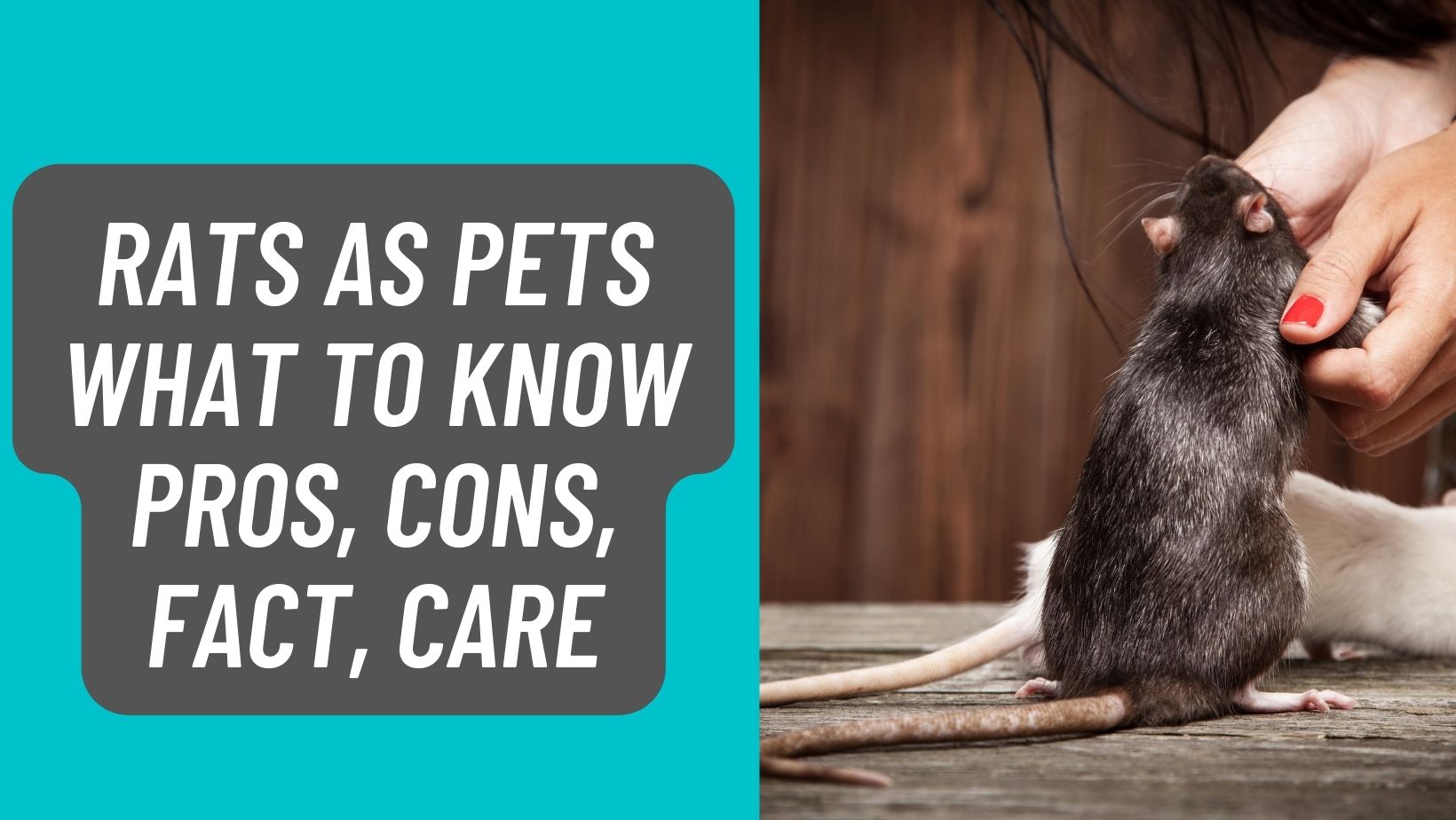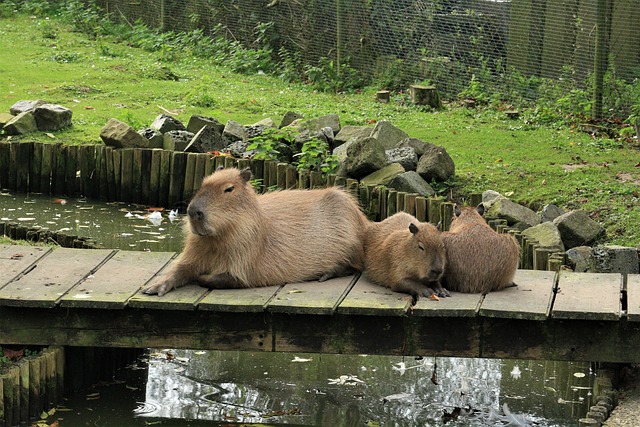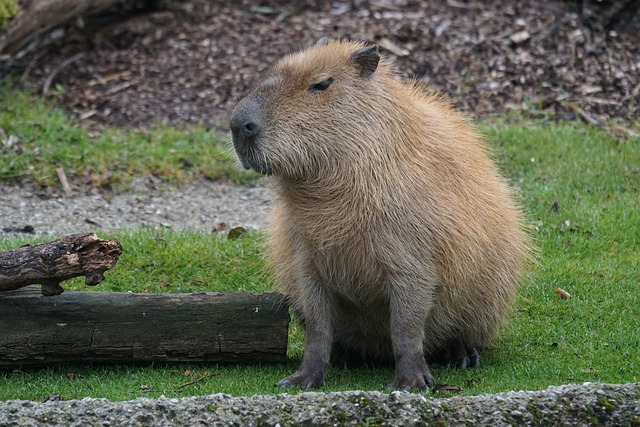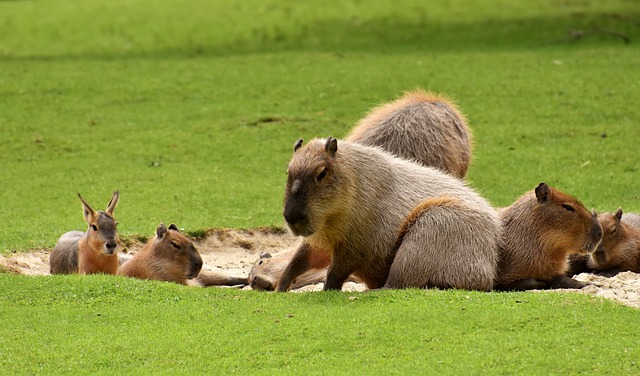Three cheers for us dears!!! Domestic Fancy Rats (Rattus Norvegicus), make excellent pets. They are very social creatures and will bond quite closely with their human keepers – providing the human in question is willing to spend lots of time with them, entertaining and stimulating their curious nature.
With a little time and lots of patience, you can even train your ratties to do some amazing tricks!
But be patient with them and they’ll be patient with you. When considering ratties as pets it is best to get them in pairs – preferably from the same litter as they will already be used to each other and saves on tricky introductions.
Another important factor when choosing your new friends – Do you want boys (Bucks)or girls (Does)? It is best to keep two of the same sex as ratties are sexually mature at 5 weeks of age, go into season every 4-5 days and can have litters of up to 15+ kittens!!! Unless you want to start your own Rattery, it is best to separate male kittens from their mother and sisters at around 41/2 – 5 weeks of age unless you want unwanted litters!
Girls Vs. Boys – Which are better? Neither is “better” or “worse” . But personalities are quite distinct. Does tend to be more excitable and very energetic. Best get your running shoes – OFF! You’ll be chasing them around the house on more than one occasion, so it’s best to be careful of delicate ratty tails and feet. Bucks are more docile and very clingy and affectionate.
As bucks get older this docility becomes full blown *Laziness*! Bless their cotton socks – couch potatoes!
Are you a light sleeper??? Well, our furry friends are nocturnal by nature, but can be coerced into daytime fun for a short while. Then back to bed for a kip until after the sun sets. While you’re sleeping away you may be disturbed by scurrying and rustling as the wee ones wake for their nocturnal horsing around.
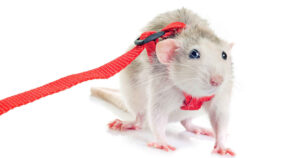
Rats as Pets Information
Are you prepared to love, honour and cherish your little ones in sickness and in health? A few common health problems with ratties can become quite time consuming and expensive, but this is true for any pet you commit to. Examples of common rattie health concerns are explained in more detail in the section “Health Problems”.
Housing
Okay, so you’ve decided to enter the WONDERFUL WORLD OF RATS! Welcome. Now where are the little peeps gonna sleep? It’s every rattie’s dream to have run of the entire human house, but this is not very safe and can lead to all sorts of accidents.
So let’s get them their own *Home Sweet Home*.
There are many commercially produced cages that will do the trick just fine. In fact some ferret cages can become the ultimate rattie condo – should you feel the need to spare the rod and spoil the child.
Tee hee hee. But let’s get some important considerations out of the way here:
First, I find that wire cages are the best – they are airy and reduce the amount of smell. Ratties scent mark their territory and can get a bit pongy – but a clean cage is a happy cage.
Wire cages are more “open” as opposed to using a tank style cage and I’m sure your ratties would appreciate not being treated as fish. Make sure the cage has a plastic or solid bottom, little feet can get trapped in wire bottoms (Bumblefoot)- and it makes cleaning the cage a more enjoyable experience.
We clean our cage every 4-5 days – depending upon how soiled the litter is. This helps keep the cage clean and free from all sorts of nasties, i.e. bad odours, mites, lice, pinworm, (more at www.rmca.org).
If you have more than two ratties you will find that you have to clean the cage more often (every 2-4 days). You don’t have to do a super duper clean, but a *spot clean* to remove most of the soiled litter should do just fine. But you will have to do a *Super duper* clean at least once a week to keep your ratties happy.
Second, make sure the cage you get is big enough. So often people think – “Oh, they’re so small, they don’t need much room.” WRONG! Unless the only time your furry friends are in their home is to sleep.
This is not always the case and often you’ll find your ratties awake and hopping about the cage like crazy persons! They need room to do this. Figure about 10 gallons per rat (2 cubic feet). So if you’ve got 2 ratties you’ll need a cage at least 20 gallons in volume (4 cubic feet).
The cage we have for Dot and Flick is 31″L x 19″w x 15″h.
This gives them just enough room to bounce around the cage should they feel the need. It also gives enough room for a few playthings – always a necessity.
Whatever cage you decide on, the ventilation should be good, place the cage in a relatively dark area, free from damp and draughts and out of direct sunlight. Ratties are very prone to hypothermia and heatstroke.
Temperatures should be between 15 and 27 degrees C (59 and 80 degrees F). Temperatures above 30 degrees C (86 degrees F) can kill ratties very quickly.
Make sure you place at least 1 cm of wood shavings (NO CEDAR OR PINE), CareFresh, BioCatolet, or other non-toxic floor covering on the bottom of the cage.
Cedar and Pine are toxic and have been shown to cause liver damage in ratties, the phenols can also lead to severe allergies and can aggravate respiratory infections.
Aspen wood pellets are an alternative to cedar and pine, but often difficult to find. Make sure the flooring has good absorptive properties, but not so much as to remove moisture from the air. Some humidity in necessary for ratties – a very dry environment can lead to respiratory infections.
Make the cage FUN! Ratties get bored very easily and need lots of amusing toys and very affectionate and playful owners. Things to add:
- Toilet paper tubes for chewing – if you can find larger cardboard tubes…. these are perfect for ratties to crawl through and hide in.
- A cozy place to hide in – there are a number of commercially produced plastic *hidey homes*. But an empty tissue box, shoe box, or other small cardboard box will do the trick quite nicely.
- What about a hammock – We have discovered yet another useful property of the *tea towel* – you can pick these up on the cheap at your local market or £ ($) store! Grab four laundry pegs and peg the towel inside the cage using the wire bars. Click here for a photo – Hammock. Shhhhhh, Dot’s sleeping.
- Play things to chew on – BELIEVE IT OR NOT – Parrot toys! These toys are perfect for ratties. They’re durable, colourful and can be hung in the cage very easily. Ratties love to chew and you’ll find these toys stand up to the rattie gnasher test.
- The Digging Pot – We’d like to thank Meg and Ratties collectives (Sayuri, Minami & Koyuki) at “RataMania” for this suggestion. Wonderful. Ratties have an inherent need to dig. So we’ve taken a shallow and wide terra cotta plant pot and filled it with potting soil. Next we took some favourite treats and buried them deep in the soil. Wuhey! What fun – messy, but great fun for the Finks (Dot and Flick). By the by, ours is too big to place inside the cage, but if you get a cage big enough it can be placed inside the cage which is less messy.
Handling
NEVER – EVER – EVER – PICK A RATTIE UP BY THE TAIL!!!
I can’t stress this enough – A Rat’s tail is a vital part of its anatomy! Without their tails, they cannot regulate their body temperature. Even the slightest jerk or quick movement can cause your rattie’s tail to disengage from the lower section of the spinal vertebrae.
This can cause severe infections which may lead to the removal of the tail to avoid further infection. So please be ever so careful when handling your ratties.
The best way to pick them up is to let them climb on you! This can be accomplished with bribery – i.e. treats and other such sundry items. Chocolate is good – IN MODERATION.
Ratties rarely bite unless frightened or in pain and should be picked up by placing a hand around their shoulders, while supporting their hindquarters in the other hand.
Interesting fact: A rat’s bite can exert 24 000 psi (pounds per square inch) – OUCH!
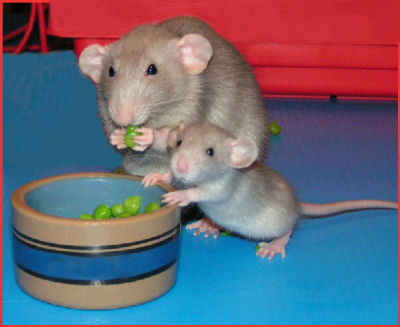
Feeding
All food should be provided in solid containers that cannot be tipped over or soiled. We use a small ceramic dish, that works great (photo). Fresh water, preferably from a sipper bottle fitted with steel ball point sleeve should be available at all times.
It is important to change the water every day to ensure that it is fresh and clean. Rats become accustomed to a set routine and are best fed at the same time each day.
Rats are omnivores, so they will eat ANYTHING. This in not always good nutrition for your ratties. A basic staple food for their diet should consist of lab blocks, maize (corn), oats and other vitamins and minerals.
This can be supplied by any commercially produced food for rats. We use Supreme Foods: Reggie Rat – it has all the goodness they need. It is also important to supplement your rattie’s diet with fresh fruit and vegetables.
No more than 10% of their food intake should be fresh fruit and vegetables or you’ll have problems with diarrhoea.
Ideally you’ll want your rattie eating a high fibre/ low fat diet. Keep the protein content around 15% – most commercially produced rat foods, i.e. Reggie Rat, Purina Rat Chow, Burgess Supa Foods etc….. have a protein content around 12-16% this is normal.
Be wary of sunflower seeds and peanuts which are found in some, these have a very high fat content and most ratties have allergic reactions to high protein/ high fat foods.
The most common allergy will manifest itself as small scabs which can be quite itchy for your ratty. Should this happen, cut out all seeds, nuts, dairy, meat and bones from your ratties list of treats – and make sure you give them detoxifying fruits and veg such as: brussel sprouts, broccoli, apples and grapes. Keep super rich and fatty foods to the bear minimum – maybe once or twice a month.
The scabs should clear up quite quickly. If they do not, you may have to take your rattie to the vet for a check-up, they could have mites/mange.
NB- Thanks to SuzyBear for mentioning that rats cannot digest alfalfa and thus do not need it in their diet – most rats won’t eat it anyway (it’s the green/brown pellets that are usually left in their food dishes when fed on Reggie Rat food).
At SueBee’s Rat World – she has been working on a rattie diet plan for quite some time. I myself haven’t tried the recipe yet, but I have spoken to a lot of rat owners who swear by it and wouldn’t feed their ratties anything else. Why not have a look and decide for yourself if this is the way you would like to go. SueBee’s World: What’s on the Menu?
Fresh fruit and vegetables should be given in moderation – otherwise your ratties will get diarrhoea. Not a happy thought – especially when it comes to cleaning the cage. Diarrhoea means an upset stomach for a rattie. How much should I feed my ratties?
The average rat will eat 2-3 tablespoons of food mix a day. Below is a list of food items that are perfect to spoil your rattie with and ensures they get all the nutrition they need. One thing to keep in mind when feeding your ratties is: MODERATION.
- Chicken Bones: Treat as a special pressie for your ratties. Chicken bones are very high in protein which can lead to skin problems if you give them too much. Honest – they’re safe – a rattie will grind the bone down into a fine powder, so the risk of choking is not a problem. It is a good way to keep your rattie’s teeth trimmed as well.
- Dog Biscuits: Once again, I must stress MODERATION. Protein content can lead to skin problems. Another good treat for rattie teeth maintenance.
- Beetroot: Cooked beetroot drive Dot and Flick *Cuckoo*! They absolutely love it! One thing to keep in mind with beetroot is it’s ability to turn their pee a bright purple colour that can be mistaken for blood. DON’T PANIC.
- Yogie Drops: This is a universal *Food of the Gods* for ratties. Those lovely little yogurt covered raisins, peanuts, coconut, whatever. Your rattie may have a preference, but trust me, these are perfect for bribery! They are small and can be given as treats when trying to coerce a shy rattie from it’s cage or when teaching your rattie a new trick.
- Chocolate: Once again, MODERATION. Chocolate is okay for ratties in small quantities and it is now believed it may help in controlling respiratory problems common in ratties.
- BioYogurt: As a responsible rat owner, you will most definitely find yourself using antibiotics (Baytril, Doxycycline, Tetracycline) at some point or another. Antibiotics are good at killing off good and bad bacteria, so after a cycle of antibiotics to clear an infection your rattie may need some help replacing the good bacteria in his digestive system. There are no reports that bio-yogurt has any affect at all in helping rattie digestion, but at least you know it’s not going to hurt them. Ours love nibbling what’s left of my brekkie in the morns: BioYogurt and Museli – yummy!
- Rice Krispies: Another food item perfect for coercing a shy rattie out of his/her cage and they are small so you can give them a few more treats than you can with Yogie Drops.
- Mealyworms and Crickets : WHAT??? Okay, so now that I’ve grossed you out, imagine if you were a rattie. You can get mealyworms and crickets at the petstore or your local fish and tackle shop. But once again, these tasties are very high in protein and should be given in…………….. you guessed it, MODERATION. *tip* – put them in the freezer if you can’t stomach your ratties eating them live. Bug-cicles. Tee hee hee.
Breeding
Okay,so you want to start a Family. THIS IS A BIG RESPONSIBILITY!
You should have no problem getting your ratties to breed if you keep males and females together. Ratties are sexually mature at 5 weeks of age, go into season every 4-5 days and can have litters of up to 15+ kittens!!!
The gestation period is approximately 3 weeks (21-23 days), so be prepared to find homes for all of the kittens BEFORE they are born. Ratties can be weaned from the mother at 6 weeks of age – from that point on they will thrive providing their new owner looks after them with lots of love and care.
If males and females are kept together, it is important to separate the parents before the arrival of the young, otherwise they will mate again within twelve hours of giving birth.
Breeding ratties is a very big responsibility – I can’t stress this enough. So often pet stores can be *wrong* about the sexes of ratties when they sell them to you.
Suddenly you find that you’ve got a mommy rat and the responsibility of a litter of 10+ kittens. It might help to read up a bit on sexing ratties BEFORE YOU BUY THEM! Then you can be sure.
This section on “Breeding” is in no way complete and there are a lot of factors to take into consideration. I can only suggest that if you are serious about breeding ratties that you do a little homework and make sure you know what you’re getting into. All the best – and cheers to happy and healthy kittens!

Health Problems
CHECK YOUR RATTIE EVERYDAY!
I am not a vet and often don’t have answers or advice for problems. The information posted here is merely to act as a guide and not as an alternative to a good and reliable veteranarian. WHEN IN DOUBT, CALL A QUALIFIED VET!
The domestic rat does not come without a huge responsibility. Are you prepared to love, honour and cherish your little friend in sickness and in health? Below are listed a few common illnesses that domestic ratties are prone to getting:
Mycoplasmosis: Most common illness. Ratties can carry this bacterium all of their lives and never suffer symptoms. But more times that not it will manifest itself as a cold. Sniffles, heavy sneezing and lethargy. If you feel your rattie has these symptoms, get thee to a vet ASAP. With a dose of antibiotics the myco (Mycoplasmosis) can be put under control – and if caught soon enough your rattie may avoid scarring of delicate lung tissue. If left untreated, pneumonia and more serious respiratory infections may occur. So it’s best to get them to the vet for a course of antibiotics.
NB-Mycoplasmosis is incurable, but can be controlled. We have our ratties on a regime of Echinacea to boost their immune systems.
Tumours: Sadly this is very common in ratties. Females are more prone to getting tumours than males. But this does not mean that males can’t get them. The older your rattie is, the more prone it is to getting tumours. Examples of tumours are, mammary tumours, Metastasis and brain tumours.
Bumblefoot: (Ulcerative pododermatitis) – Usually happens when your ratties feet get cut/scratched from walking on rough litter or wire cage bottoms. It is caused by the bacteria associated with what is commonly called a “Staph infection”- the bacteria can enter the cuts/abrasions on little rattie feet from there the bacterium will cause an abscess which can burst and bleed. The best cure is a course of antibiotics and the use of a topical antibacterial ointment called “Blue-Kote”.
Skin Problems: Ratties are very sensitive to their diets. If they are getting too much protein, they can suffer, abscesses, dry skin, acne and scabbing. So keep an eye on their skin and fur. A rattie’s coat should be shiny and glossy for does.
Bucks fur tends to be a bit more coarse, but should still be very shiny and glossy in appearance. If you find dandruff flakes, check your rattie THOROUGHLY – what may appear to be harmless flakes of dandruff could very well be the remains of hatched lice/mite eggs.
If your rattie has been doing some excessive scratching to the point where his/her fur is gone in patches it may be that there is an infestation of mites/lice/mange. This can be treated with a dose of ‘ivermectin’ from your vet.
Or even commercially produced small rodent shampoos can control the problem depending upon severity of infestation. Be wary of Dog and cat shampoos – these are toxic to smaller pets.
Barbering: The fight for dominancy! Rattie societies call for alpha heirarchies. That is to say, in groups of 2+ ratties there will be one that wants to be the leader, “The King/Queen of the Hill”.
To achieve this noble status they may fight with one another (common amongst males) or chew the fur and whiskers of the more submissive ratties (common amongst females).
Not to worry, it is best to separate your rats when they do this as it is not a learned behaviour, but a natural and inherent behaviour that insures survival of the species.
You can try and become the alpha rattie in the society – this may sound strange, but if your ratties start this bahaviour you must act quickly and jump in.
Using your hand try and gently flip the dominant/bullying rattie over on his/her back and lightly tickle their belly. If you hear a squeak, then stop. They will learn that you are the one to reckon with.
Bruxing: This is what your rattie does to look beautiful. Ratties are very clean ‘nimals and love to groom themselves and each other. This can become an obsessive compulsive disorder in some ratties to the point where they remove the fur from their forearms. A sure sign that your rattie may be stressed, bored, lonely, or even ill.
Porphyrin Staining: This is not a problem in and of itself, but may indicate a serious problem, usually associated with respiratory infections (see Mycoplasmosis above). This is a brown/purple/reddish substance produced by a gland behind the eye (the Harderian Gland) which dries the colour of blood.
You will find a smearing of Porphyrin around the eyes and nose of a rattie who is *stressed* – Some ratties are so “Laid-Back” that you may not get porphyrin staining, but they may still be sick.
So, learn what your rattie’s healthy breathing sounds like – this way if something is wrong you will be able to tell the difference between a raspy laboured breathing and clean and clear lungs.
Inner Ear Infections: I must admit that this is a very common occurrence in ratties. First let me explain that ratties are *short-sighted* creatures and can not focus very well on objects more than appx. 2 feet away. S
o, they tilt or weave their heads to focus better. Now a rattie inner ear infection will also cause your rattie to tilt his/her head. If this happens it’s best to take them to a vet for a course of antibiotics. PEW (pink eyed white) and maroon or ruby eye coloured rats have even worse eyesight (poor things).
Dental Concerns: A rat’s teeth will grow constantly! So it’s important to put things in their cage they can chew on to keep their teeth trim. Otherwise you’ll have a rattie with a bad underbite and this may cause lacerations in the mouth which can be painful.
We suggest bits of wood (NO CEDAR or PINE), dog biscuits are good too (IN MODERATION). Even those doggie rawhide chew bones work a treat! Sometimes a rattie may lose a tooth! But do not worry too much, it will begin to grow back relatively quickly (3-6 weeks).
Rattie Manicures: Sometimes your rattie’s nails can become too long and can scratch delicate ears, noses, mouths when they’re horsing around with one another.
It’s important to put something in the cage that can keep these dangerous claws trim. We use half of a rough brick, it seems to do the trick. Rattie’s skin is relatively insensitive so they may not notice a severe scratch from their flat mate – so check your ratties every day and make sure there are no abrasions, scabs, lacerations.
You can trim your ratties nails, but this is very tricky and also very dangerous. It might be best to take your little friend to a vet and have this done along with a check of the gnashers (teeth) to make sure they are not too long.
If you do accidentally snip the nail too short and it begins to bleed, a dab of cornstarch should stop the bleeding as long as you haven’t cut too deep into the vein inside the nail.
Allergic to your rats?: A lot of people complain of itchy, red, blotchy skin after playing with their ratties. It is not so much their fur that is causing the reaction – it is their urine. Ratties love to *wet the bed* – this is just the way they are, sleeping in a place that smells like they do. It’s important to change their sleeping quarters every 3-4 days to help with this allergic reaction.
You may find that bathing your ratties helps. This is a tricky thing – some ratties love the water others will claw your eyes out to keep from getting wet.
Bathing Tips: We run about 1 inch or so of very luke warm water into the kitchen sink and put about a teaspoon of bubble bath into the water – you don’t have to use any soap if you’re worried about it, but it will not hurt them. Let them move into it at their own pace – and always have your towel at the ready should they decide enough is enough. Our ratties love bathtime! Go figure………….??? ~~~( 8:>
Rat Stats:
| Life expectancy | Weight in grams | Duration of pregnancy | Size of litter | Age of weaning | Ideal temperature | Heartrate (beats/min.) | Respiratory rate (breaths/min.) |
| 26-48 mo. | F 225-325 M 275-500 | In days 21-23 | 8-12 | 4 wks | 70-75 F | 300-550 | 60-120 |
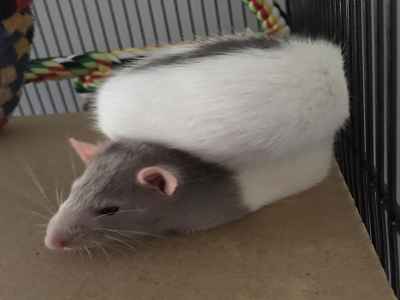
Herbal Remedies and Rats
Herbal remedies are gaining in popularity where it concerns animal health. We have Dot and Flick on a regime of Echinacea (Echinacea purpurea) at the first of every month for fourteen days on then off the rest of the month.
The reason for the break in dosage is due to the possibility of the ratties becoming immune to the beneficial properties of Echinacea. We use ‘Herbal Authourity’ Echinacea in a base of vegetable glycerine so it’s Alcohol Free.
Just put 10 drops in their water bottle filled with 100ml of water. We’ve been doing this now for 6 months and I’m happy to say that we have not had to take them into the vets for the usual dose of Baytril or other antibiotic to combat a respiratory infection. So who knows if it is the Echinacea that is to thank for this, but better safe than sorry and it has no known toxicity effects so it is relatively safe.
NB – As safe as most herbal remedies are, they should not be treated as an alternative to proper veterinary care. Herbal remedies are a means of preventing a lot of common illnesses and can help keep your ratty healthy, but if in doubt it’s best to consult with a vet and make sure your rattie is getting the proper care and medicine he/she needs.
NB – It is also worth noting that some plants can be mild to extremely toxic to small animals. So do some reading on the subject. Here’s a good place to start – Toxic Plants
Below are a few herbs and their medicianal properties, just click on the herb and it will take you to the relevant page at the Herb Research Foundation
| Echinacea Echinacea purpurea | Ginseng Panax ginseng | Ginkgo Ginkgo biloba |
First Aid
The following is a list of things to have on hand should your little friend fall into danger and hurt themselves. By no means is it an alternative for proper vetrinary care! But could help alleviate a lot of pain, bleeding or injury until such time as you can get your rattie to a vet.
- Activated Charcoal – found in most health food stores, sold as capsules.
If you suspect that your rat has consumed something toxic, including rat poison. Use half a capsule mixed in a teaspoon of jam. Let the rat eat as much as it wants. - Baby Aspirin – found in most pharmacies, supermarkets and newsagents.
For the immediate relief of pain and swelling. Use 1/8 to 1/4 of an aspirin, crushed and mixed in a teaspoon of jam. Please note: Acetaminophen is toxic to small animals so make sure it is aspirin. - Bach’s Rescue Remedy – found in most pharmacies, herbal remedy shops or health food stores.
For anxiety, stress, depression, and shock. In an emergency give straight from the stock bottle. Give 1 drop by mouth, or rubbed into the back of the ear or the tail, once every 5 minutes, until results can be seen. - Savlon or Neosporin – antibacterial ointment for skin irritations.
Medicated salve for minor cuts, scratches, and abrasions. - Benadryl for Children – found in most pharmacies.
An antihistamine for the relief from allergies, respiratory ailments, and insect bites. Give 1 to 2 drops orally. - Blacklight – these are expensive and not really necessary, but can be quite amusing.
To see if that’s blood or porphyrin around your rat’s nose and/or eyes. Porphyrin glows, blood doesn’t.
If your rattie has porphyrin staining or blood around nose and/or eyes, it’s best to get them to a vet. It may mean they are stressed or ill. - Dr. Naylor’s Blue-Kote – an equivalent is a purple spray/ointment for horses that can be found at most farm animal supply stores.
A germicidal/fungicide spray used for bumblefoot and ringworm. - Cotton makeup pads – relatively inexpensive to buy.
Perfect for cleaning small wounds, applying medicinal ointments and wiping ratty faces clean. - Cotton buds – don’t get the cheap kind, they fall apart too easily.
Use to clean wounds and remove specks from around eyes, ears, nose, and mouth. - Flea Comb – can be found in pet stores.
A very fine-toothed comb helpful in removing mites, lice, dirt and scabs, which start to heal. - Hand Towel –
To wrap injured rat in. - Hospital/travel Cage – We picked one up on the cheap at a flea market (20p).
It’s big enough to transport two ratties, but not so big as to be a burden when travelling by foot. An injured rat may have to be kept separated from its cage mates. - Humidifier – vaporiser
Puts moist warm heat back into the rat room when the air is too dry – dry air can make a rattie cough and wheeze. Changes in environment may cause sneezing as well and sometimes a quick 1-hour run from a humidifier will clear up the sneezing. A vaporiser can be used to put medication in the air as well; e.g. Olbas oil (inhalant decongestant) – similar to Vick’s VapoRub. - Ivermectin – this can be found at most farm animal supply stores.
A horse wormer used to treat mites and other coat/skin pests. Use a dose the size of 1/2 of an uncooked grain of white rice. Mix with a favourite food. Give once a week for 3 weeks. - Styptic Powder –
Stops bleeding from superficial wounds and broken nails. If you cannot find styptic powder, cornstarch will do the trick just as well. Toxic/Poisonous Plants
The following plants are all dangerous to some degree. Some, like oleander and Dieffenbachia (dumb cane) can cause death almost instantly. Others may cause only a mild reaction, but it is still best to remove them from any areas where they would be in contact with your pet.
This is not a complete list, so if you are in any doubt about the safety of plants that you have, please contact your veterinarian or the National Animal Poison Control Centre.
For more information on toxic properties please visit Vet Med Library – A more complete listing with helpful photographs.
| Air plant Amanita Amaryllis American yew Andromeda Arum lily Autumn crocus Australian flame tree Avocado AzaleaBalsam pear Baneberry Bird of paradise Bishop’s weed Black laurel Black locust Bloodroot Bluebonnet Blue-green algae Boxwood Bracken fern Broad beans Broomcorn grass Buckeye Buckthorn Bulb flowers Burdock ButtercupCacao Camel bush Castor bean Caladium Calla lily Candelabra tree Cardinal Castor Bean Chalice vine Cherry tree Chinaberry tree Christmas candle Clematis Cocklebur Coffee Coffee bean Coral plant Coriander Corncockle Cotton bush Coyotillo Cowslip Crown of thorns CutleafDaffodil Daphne Datura Deadly amanita Death camus Delphinium Devil’s ivy Dieffenbachia Dutchman’s breechesEggplant ElderberryElephant’s ear English ivy English yew Ergot Eucalyptus Euonymus | False hellebore False henbane Flame tree Felt plant Firethorn Four O’Clock FoxgloveGhostweed Glottidium Golden chain Ground cherryHeliotrope Hemlock Henbane Holly Honeysuckle Horse bean Horse chestnut Horsetail Hyacinth HydrangeaIndian licorice Inkberry Indian turnip IrisJack-in-the-pulpit Java bean Lima bean Jasmine Jerusalem cherry JimsonweedJohnson grass JuniperKentucky coffee treeLantana Larkspur Laurel Leucotho Lily-of-the-valley Lima bean Lobelia Locoweed Lords and ladies Lupine
Malanga | Narcissus Navy bean Nettles NightshadesOak OleanderPanda plant Parsley Peires Pencil tree Periwinkle Philodendrons Pigweed Pikeweed Poinciana Poinsettia Poison ivy Poison oak Pokeweed Potato (raw) Precatory Privet PyracanthaRain tree Ranunculus Rape Rattlebox Rattlebush Red maple Rhubarb Rhododendrons Rosary peasSandbox tree Scarlet runner Skunk cabbage Sorghum grass Sorrel Spindle tree Snowdrop Snow on the mountain SpurgesSt. John’s Wort Sudan grass Sweet peaTansy ragwort Tobacco ThornappleVetch Virginia bower Virginia creeper Wattle Yam bean |

